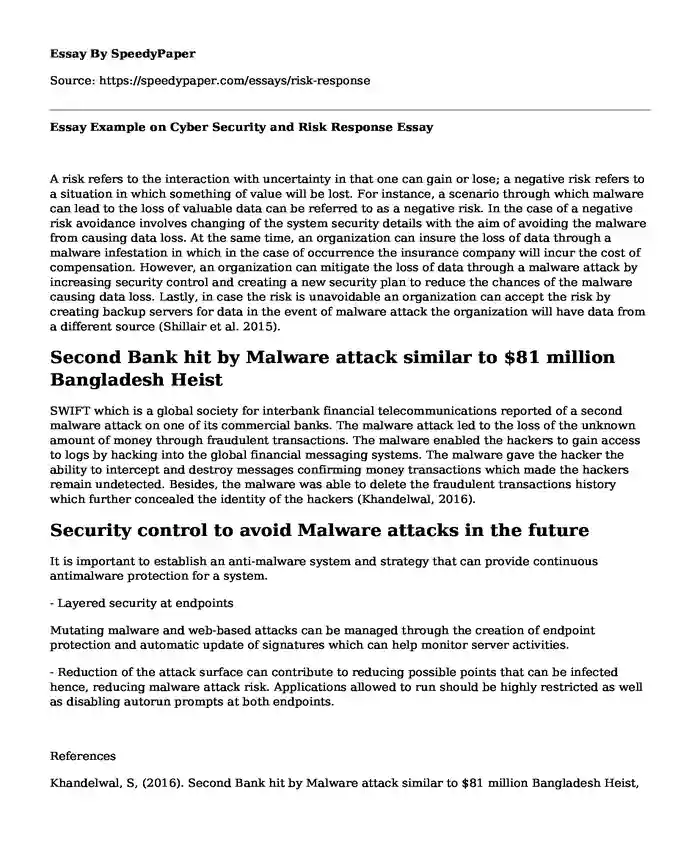
| Type of paper: | Essay |
| Categories: | Risk Information technologies Cyber security |
| Pages: | 2 |
| Wordcount: | 459 words |
A risk refers to the interaction with uncertainty in that one can gain or lose; a negative risk refers to a situation in which something of value will be lost. For instance, a scenario through which malware can lead to the loss of valuable data can be referred to as a negative risk. In the case of a negative risk avoidance involves changing of the system security details with the aim of avoiding the malware from causing data loss. At the same time, an organization can insure the loss of data through a malware infestation in which in the case of occurrence the insurance company will incur the cost of compensation. However, an organization can mitigate the loss of data through a malware attack by increasing security control and creating a new security plan to reduce the chances of the malware causing data loss. Lastly, in case the risk is unavoidable an organization can accept the risk by creating backup servers for data in the event of malware attack the organization will have data from a different source (Shillair et al. 2015).
Second Bank hit by Malware attack similar to $81 million Bangladesh Heist
SWIFT which is a global society for interbank financial telecommunications reported of a second malware attack on one of its commercial banks. The malware attack led to the loss of the unknown amount of money through fraudulent transactions. The malware enabled the hackers to gain access to logs by hacking into the global financial messaging systems. The malware gave the hacker the ability to intercept and destroy messages confirming money transactions which made the hackers remain undetected. Besides, the malware was able to delete the fraudulent transactions history which further concealed the identity of the hackers (Khandelwal, 2016).
Security control to avoid Malware attacks in the future
It is important to establish an anti-malware system and strategy that can provide continuous antimalware protection for a system.
- Layered security at endpoints
Mutating malware and web-based attacks can be managed through the creation of endpoint protection and automatic update of signatures which can help monitor server activities.
- Reduction of the attack surface can contribute to reducing possible points that can be infected hence, reducing malware attack risk. Applications allowed to run should be highly restricted as well as disabling autorun prompts at both endpoints.
References
Khandelwal, S, (2016). Second Bank hit by Malware attack similar to $81 million Bangladesh Heist, The Hacker News, Thursday, May 12, 2016. Web
http://thehackernews.com/2016/05/swift-bank-hack.htmlShillair, R., Cotten, S. R., Tsai, H. Y. S., Alhabash, S., LaRose, R., & Rifon, N. J. (2015). Online safety begins with you and me: Convincing Internet users to protect themselves. Computers in Human Behavior, 48, 199-207.
Symantec.com (Best security practices)
https://www.symantec.com/page.jsp?id=stopping_malware
Cite this page
Essay Example on Cyber Security and Risk Response. (2019, Nov 25). Retrieved from https://speedypaper.com/essays/risk-response
Request Removal
If you are the original author of this essay and no longer wish to have it published on the SpeedyPaper website, please click below to request its removal:
- Pressure on Girls to Have Perfect Bodies, Media Influence Essay Sample
- Abraham Lincoln and Religion: 1861-1865, Free Essay for Everyone
- Mrs. Dutta Writes a Letter - Free Essay in Literature
- Essay Sample on Electronic Medical Record (EMR) Training Plan
- Scientific Writing for Expert audience: Assignment scoring criteria
- The Impact of Poor Local Government Investment on Ex-Convicts on High Recidivism Rate
- Essay Sample on History of the Business Industry
Popular categories




